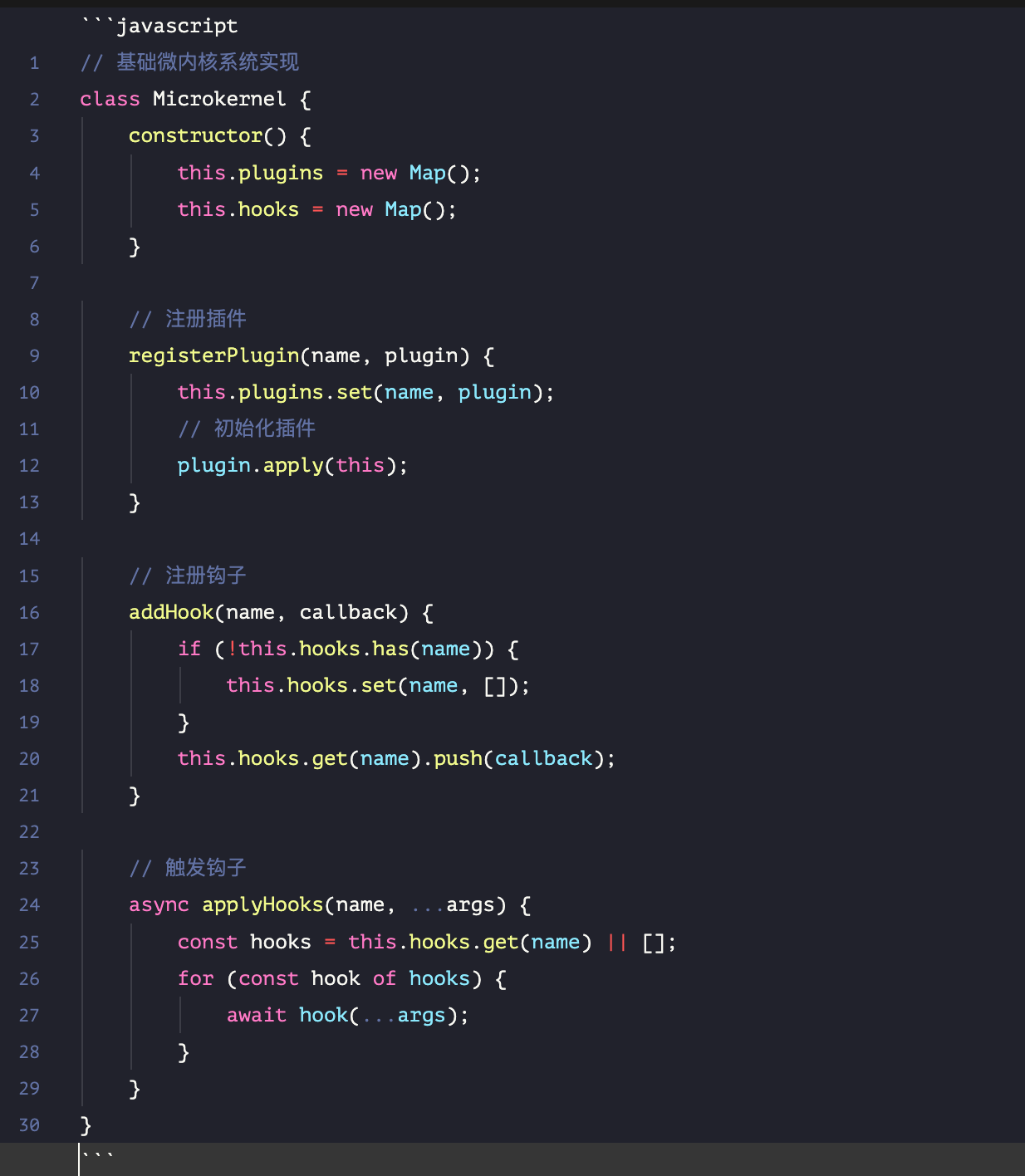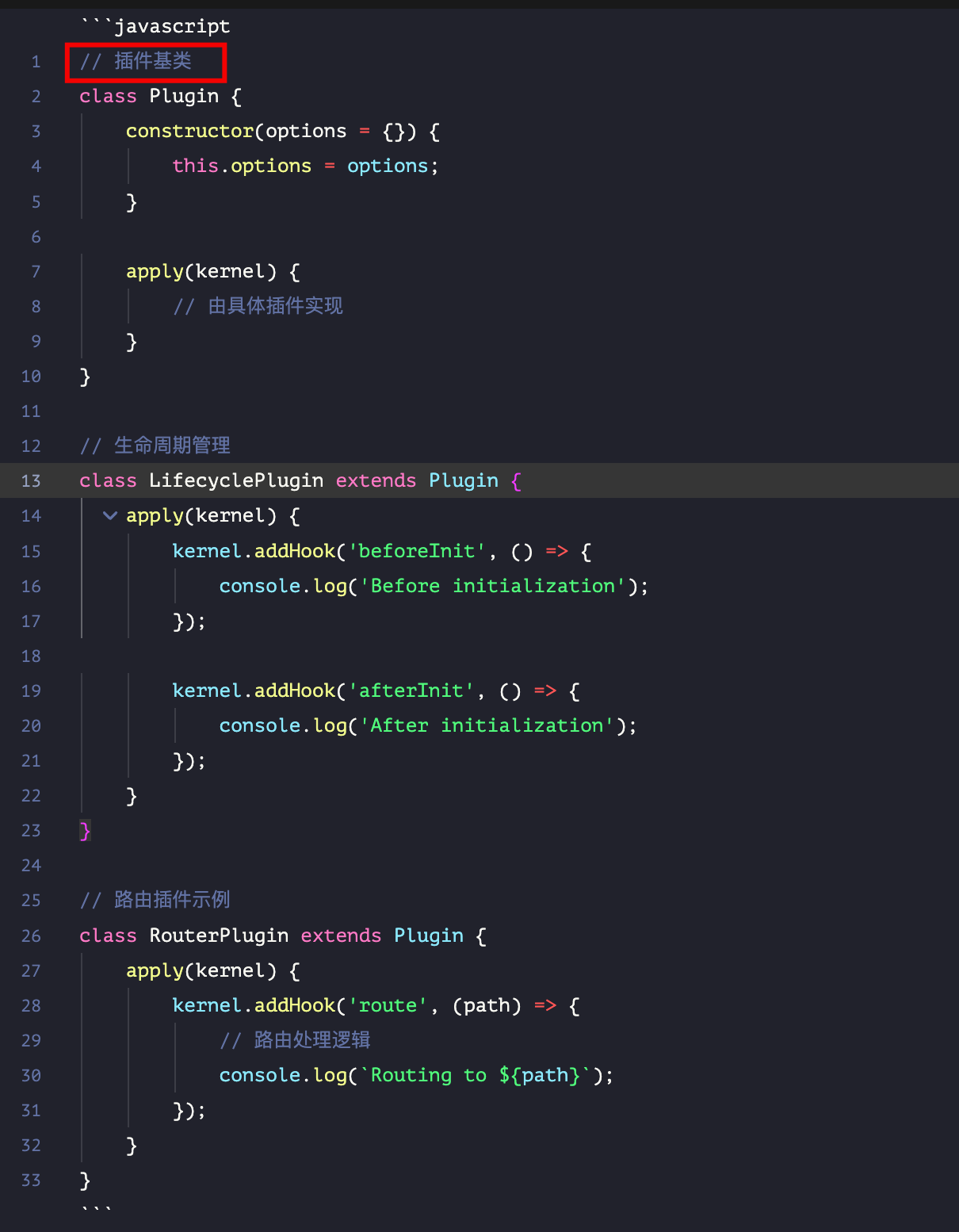前端常见的架构思路:篇一
#前端架构
目录
- 总结
- 1. 分层架构
- 2. 模块化结构
- 3. 管道和过滤器
- 4. 事件驱动/发布-订阅
- 5. 复制:fork 风格
- 6. 组件化架构(Component-Based Architecture)
- 7. 模块化架构(Modular Architecture)
- 8. 微服务前端架构(Micro-Frontend Architecture)
- 9. 单向数据流:Flux/Redux 架构
- 10. 微内核架构,又称为”插件架构”
- 11. 实践建议
- 12. 好的架构应该是
总结
- 分层架构
- mvc
- MVVM
- vdom
- 前中后台
- 语言抽象的层次越高
- 一般运行效率可能会有所衰减
- 看
js/ts/c/汇编/机器码等等等
- 前端框架的分层
- 表现层
- 用户界面
- 路由管理
- 业务层
- 业务逻辑
- 状态管理
- 数据层
- API 调用
- 数据持久化
- 表现层
- 模块化结构 → 将应用分解为独立的功能模块
- esm commonjs
- 管道和过滤器:数据流处理,每个处理单元==独立且可组合==
- gulp pile
- koa 中间件
- 洋葱模型也有
管道的影子
- 洋葱模型也有
vue的filter- Node 中
流的
- 事件驱动/发布-订阅 → 松耦合
- fork 风格:复制共享状态或资源来实现并行处理的架构模式
- nodejs
- 比如
nodeJS的Cluster 模块Cluster’这个词在计算机科学中通常指的是一组计算机或服务器
- 比如
- web worker
- 多线程等
- nodejs
- 组件化架构:
- 将UI和功能封装成独立、可重用的组件
- 高内聚、低耦合
- 将UI和功能封装成独立、可重用的组件
- 微前端架构:
- 将前端应用分解为多个独立的微前端应用
- 单向数据流:Flux/Redux 架构
- 微内核架构,又称为”插件架构”
- 核心系统
- 插件模块
- 比如
Webpack、Babel、PostCSS以及ESLint - 比如
jQuery插件:简单说就是jQuery.prototype.extend用于扩展插件
- 比如
- 实现要点:
- 微内核
- 插件系统
- 插件间通讯
- 事件驱动的插件系统
- 微内核
1. 分层架构
核心思想:关注点分离,每层只负责特定功能。
没有什么问题是分层解决不了,如果解决不了, 就再加一层
- 比如
网络协议,越来高层面向人类,底层面向机器 - 又比如现在所谓的
后台、中台、前台 - 又比如,语言抽象的层次越高,一般运行效率可能会有所衰减,看
js/ts/c/汇编/机器码等等等 - 又比如,mvc 、MVVM 等等
回到,前端:
V-dom,就是之前DOM上的一个分层- 开发方式由之前
jQuery方式变成了view=f(state)方式
- 开发方式由之前
1.1. 示例:MVC 架构
- Model (模型): 数据和业务逻辑
- View (视图): 用户界面
- Controller (控制器): 处理用户输入,协调 Model 和 View
// Model
class UserModel {
constructor(name, age) {
this.name = name;
this.age = age;
}
updateName(name) {
this.name = name;
}
}
// View
class UserView {
render(user) {
return `<div>
<h1>${user.name}</h1>
<p>Age: ${user.age}</p>
</div>`;
}
}
// Controller
class UserController {
constructor(model, view) {
this.model = model;
this.view = view;
}
updateUserName(name) {
this.model.updateName(name);
this.refreshView();
}
refreshView() {
const html = this.view.render(this.model);
document.body.innerHTML = html;
}
}
1.2. 示例 2:MVVM
- Model: 数据模型
- View: 视图层
- ViewModel: 视图模型,处理视图逻辑
Vue.js 示例
// MVVM 实现示例 (Vue)
const app = new Vue({
// View Model
data: {
message: 'Hello MVVM'
},
methods: {
updateMessage(newValue) {
this.message = newValue;
}
},
// View
template: `
<div>
<h1>{{message}}</h1>
<input v-model="message">
</div>
`
});
1.3. 示例 3:前端框架的分层
- 表现层
- 用户界面
- 路由管理
- 业务层
- 业务逻辑
- 状态管理
- 数据层
- API 调用
- 数据持久化
// 分层架构示例
// API 层
class UserAPI {
static async getUser(id) {
return await fetch(`/api/users/${id}`);
}
}
// 服务层
class UserService {
static async getUserInfo(id) {
const user = await UserAPI.getUser(id);
return this.formatUserData(user);
}
static formatUserData(user) {
// 数据处理逻辑
return {
...user,
fullName: `${user.firstName} ${user.lastName}`
};
}
}
// 视图层
class UserComponent extends React.Component {
async componentDidMount() {
const user = await UserService.getUserInfo(this.props.id);
this.setState({ user });
}
render() {
// 渲染逻辑
}
}
2. 模块化结构
- ES Modules
- CommonJS
- AMD/RequireJS
3. 管道和过滤器
核心思想:数据流处理,每个处理单元独立且可组合。
- 比如在
Angular里就有管道概念 - gulp的
pipe - 甚至
koa里的洋葱模型也有管道的影子(中间件) vue的filter如{{ message | capitalize }}- Node 中
流的概念
4. 事件驱动/发布-订阅
核心思想:
- 通过事件的发布和订阅实现松耦合。
5. 复制:fork 风格
Fork 风格是一种通过复制共享状态或资源来实现并行处理的架构模式。在前端中,主要用于:
- 状态管理
- 并行计算
- 数据隔离
- 多线程处理
5.1. Web Worker 中的 Fork
5.2. 比如nodeJS的 Cluster 模块
- Node.js 中的集群模块,允许创建
多个工作进程来处理并发请求 - ‘
Cluster’ 这个词在计算机科学中通常指的是一组计算机或服务器,它们一起工作以提供更高的性能和可用性
const cluster = require('cluster');
const http = require('http');
const numCPUs = require('os').cpus().length;
if (cluster.isMaster) {
console.log(`Master ${process.pid} is running`);
// Fork workers.
for (let i = 0; i < numCPUs; i++) {
cluster.fork();
}
cluster.on('exit', (worker, code, signal) => {
console.log(`worker ${worker.process.pid} died`);
});
} else {
// Workers 可以共享任意的TCP连接
// 比如 共享HTTP服务器
http.createServer((req, res) => {
res.writeHead(200);
res.end('hello world\n');
}).listen(8000);
console.log(`Worker ${process.pid} started`);
}
6. 组件化架构(Component-Based Architecture)
核心思想:==将UI和功能封装成独立、可重用的组件==。
- 设计原则
- 单一职责
- 高内聚、低耦合
- 可复用性
7. 模块化架构(Modular Architecture)
核心思想:将应用分解为独立的功能模块
8. 微服务前端架构(Micro-Frontend Architecture)
核心思想:将前端应用分解为多个独立的微前端应用。
- 应用独立开发、部署
- 技术栈无关
- 独立运行时
9. 单向数据流:Flux/Redux 架构
- Store: 状态容器
- Action: 动作描述
- Reducer: 状态计算
- Dispatcher: 分发器
10. 微内核架构,又称为”插件架构”
10.1. 基本概念
微内核架构主要包含两部分:
- 核心系统(Microkernel):提供最基本的功能
- 插件模块(Plugins):提供扩展功能
- 微内核结构的难点在于建立一套粒度合适的插件协议、以及对插件之间进行适当的
隔离和解耦。- 从而才能保证良好的扩展性、灵活性和可迁移性。
- 前端领域比较典型的例子是
Webpack、Babel、PostCSS以及ESLint,- 这些应用需要应对复杂的定制需求,而且这些需求时刻在变,只有微内核架构才能保证灵活和可扩展性。
- 比如
jQuery插件:简单说就是jQuery.prototype.extend用于扩展插件
// jQuery 入口函数
var jQuery = function (selector, context) {
return new jQuery.init(selector, context);
};
// jQuery 核心原型定义,也是 jQuery plugin 的扩展接口
jQuery.fn = jQuery.prototype = {
hello: function hello() {
console.log("hello world");
},
//... 其他定义
};
// 另一种扩展 plugin 的便捷方法,接收一个对象
jQuery.extend = jQuery.fn.extend = function(targetObj) {
// 克隆 targetObj
}
// jQuery 真正的实例化构造函数
var init = function (selector, context) {
// init dom elements
}
init.prototype = jQuery.fn;
jQuery.init = init;
$ = jQuery;
下面介绍前端微内核架构(Plugin Architecture)的设计思路和实现方式:
10.2. 基础微内核系统实现
// 基础微内核系统实现
class Microkernel {
constructor() {
this.plugins = new Map();
this.hooks = new Map();
}
// 注册插件
registerPlugin(name, plugin) {
this.plugins.set(name, plugin);
// 初始化插件
plugin.apply(this);
}
// 注册钩子
addHook(name, callback) {
if (!this.hooks.has(name)) {
this.hooks.set(name, []);
}
this.hooks.get(name).push(callback);
}
// 触发钩子
async applyHooks(name, ...args) {
const hooks = this.hooks.get(name) || [];
for (const hook of hooks) {
await hook(...args);
}
}
}
10.3. 插件系统实现
// 插件基类
class Plugin {
constructor(options = {}) {
this.options = options;
}
apply(kernel) {
// 由具体插件实现
}
}
// 生命周期管理
class LifecyclePlugin extends Plugin {
apply(kernel) {
kernel.addHook('beforeInit', () => {
console.log('Before initialization');
});
kernel.addHook('afterInit', () => {
console.log('After initialization');
});
}
}
// 路由插件示例
class RouterPlugin extends Plugin {
apply(kernel) {
kernel.addHook('route', (path) => {
// 路由处理逻辑
console.log(`Routing to ${path}`);
});
}
}
10.4. Webpack 风格的插件系统
// Webpack风格的编译器实现
class Compiler {
constructor() {
this.hooks = {
start: new SyncHook(),
compile: new AsyncSeriesHook(['compilation']),
done: new SyncHook(['stats'])
};
this.plugins = [];
}
// 应用插件
use(plugin) {
this.plugins.push(plugin);
plugin.apply(this);
}
// 运行编译
async run() {
this.hooks.start.call();
const compilation = {};
await this.hooks.compile.promise(compilation);
this.hooks.done.call({ success: true });
}
}
// Webpack风格的插件示例
class MyPlugin {
apply(compiler) {
compiler.hooks.start.tap('MyPlugin', () => {
console.log('开始编译');
});
compiler.hooks.compile.tapAsync('MyPlugin', async (compilation, callback) => {
console.log('编译中...');
await someAsyncTask();
callback();
});
compiler.hooks.done.tap('MyPlugin', (stats) => {
console.log('编译完成');
});
}
}
10.5. UmiJS 风格的插件系统
// UmiJS风格的服务实现
class UmiService {
constructor() {
this.plugins = [];
this.hooks = {};
}
// 注册插件
registerPlugin(plugin) {
this.plugins.push(plugin);
}
// 应用插件
applyPlugins() {
this.plugins.forEach(plugin => {
plugin.apply({
api: this.getAPI(),
service: this
});
});
}
// 获取API接口
getAPI() {
return {
// 修改配置
modifyConfig: (fn) => {
this.hooks.modifyConfig = fn;
},
// 添加路由
addRoutes: (routes) => {
this.hooks.addRoutes = routes;
}
};
}
}
// UmiJS插件示例
class UmiPlugin {
apply({ api }) {
// 修改配置
api.modifyConfig((config) => {
return {
...config,
// 添加配置
};
});
// 添加路由
api.addRoutes([
{
path: '/custom',
component: './CustomPage'
}
]);
}
}
10.6. 事件驱动的插件系统
// 事件驱动的插件系统
class EventDrivenCore {
constructor() {
this.events = new Map();
this.plugins = new Set();
}
// 注册插件
use(plugin) {
this.plugins.add(plugin);
plugin.setup(this);
}
// 注册事件监听
on(event, handler) {
if (!this.events.has(event)) {
this.events.set(event, new Set());
}
this.events.get(event).add(handler);
}
// 触发事件
emit(event, ...args) {
const handlers = this.events.get(event);
if (handlers) {
handlers.forEach(handler => handler(...args));
}
}
}
// 事件驱动插件示例
class LoggerPlugin {
setup(core) {
core.on('request', (req) => {
console.log(`${new Date()}: ${req.url}`);
});
}
}
10.7. 可配置的插件系统
// 配置系统
class Config {
constructor(initialConfig = {}) {
this.config = initialConfig;
}
get(key) {
return this.config[key];
}
set(key, value) {
this.config[key] = value;
}
merge(newConfig) {
this.config = {
...this.config,
...newConfig
};
}
}
// 可配置的插件核心
class ConfigurableCore {
constructor() {
this.config = new Config();
this.plugins = new Map();
}
// 使用插件
use(plugin, options = {}) {
const instance = new plugin(options);
this.plugins.set(plugin.name, instance);
instance.apply(this);
}
// 获取配置
getConfig() {
return this.config;
}
}
// 可配置插件示例
class ThemePlugin {
constructor(options) {
this.options = options;
}
apply(core) {
core.getConfig().merge({
theme: this.options.theme || 'light'
});
}
}
10.8. 插件通信机制
// 插件间通信系统
class PluginMessenger {
constructor() {
this.channels = new Map();
}
// 创建通信通道
createChannel(name) {
if (!this.channels.has(name)) {
this.channels.set(name, new Set());
}
return {
send: (message) => this.broadcast(name, message),
subscribe: (handler) => this.subscribe(name, handler)
};
}
// 广播消息
broadcast(channel, message) {
const subscribers = this.channels.get(channel);
if (subscribers) {
subscribers.forEach(handler => handler(message));
}
}
// 订阅消息
subscribe(channel, handler) {
if (!this.channels.has(channel)) {
this.channels.set(channel, new Set());
}
this.channels.get(channel).add(handler);
}
}
// 使用通信的插件示例
class DataPlugin {
apply(core) {
const channel = core.messenger.createChannel('data');
// 发送数据
channel.send({ type: 'update', data: {} });
}
}
class UIPlugin {
apply(core) {
const channel = core.messenger.createChannel('data');
// 接收数据
channel.subscribe((message) => {
if (message.type === 'update') {
this.updateUI(message.data);
}
});
}
}
微内核架构的优点:
- 高度可扩展
- 模块化程度高
- 核心功能精简
- 插件按需加载
- 维护成本低 使用场景:
- 构建工具(Webpack、Rollup)
- 框架(UmiJS、VuePress)
- 编辑器插件系统
- 应用扩展系统 需要注意的问题:
- 插件依赖管理
- 插件加载顺序
- 插件冲突处理
- 性能开销控制
- 版本兼容性
11. 实践建议
- 不要过度设计
- 保持架构的灵活性
- 考虑未来的扩展性
- 关注代码的可测试性
- 注重开发效率和维护成本
12. 好的架构应该是
- 清晰易懂
- 易于维护
- 便于扩展
- 性能优良
- 适合团队

